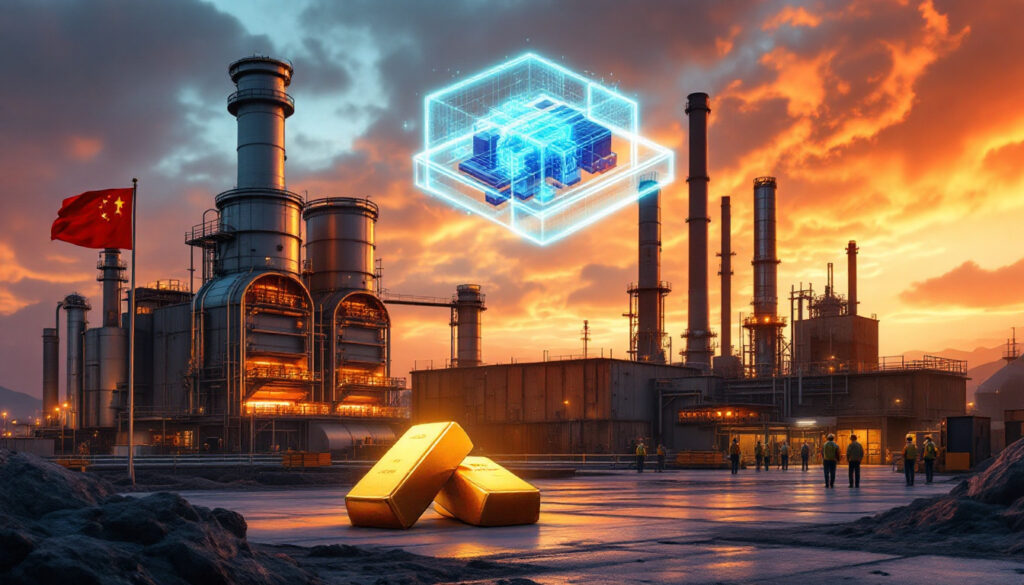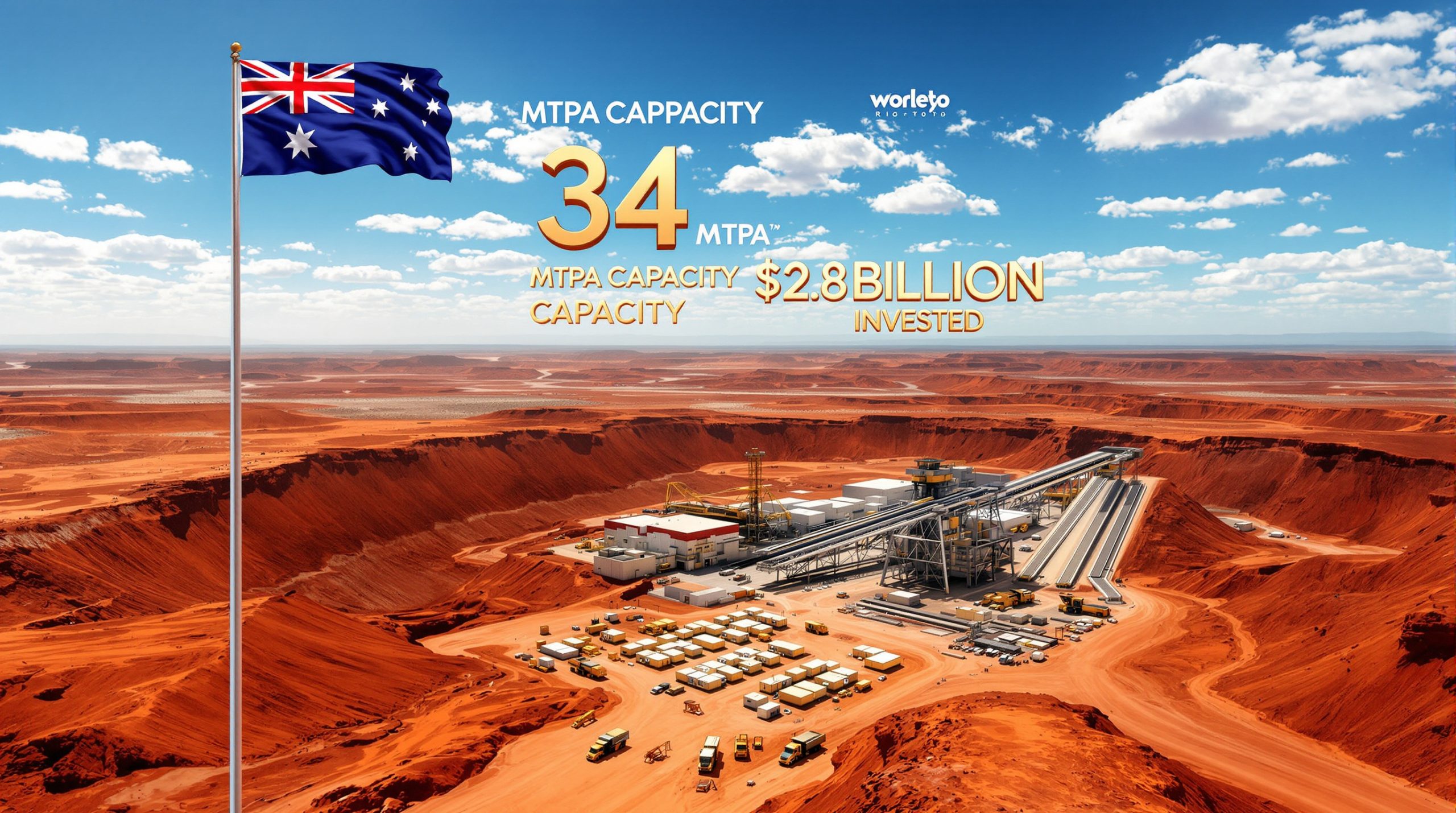The Role of Gold Byproducts in Sustaining China's Copper Smelting Industry Amidst Economic Challenges
China's copper smelting sector is navigating unprecedented economic pressures due to collapsing treatment charges, yet record gold prices and technological advancements in byproduct recovery are enabling operational continuity. This complex dynamic illustrates how interconnected metal markets can create surprising resilience even in challenging economic conditions. Recent gold market analysis shows that precious metals have become increasingly vital to the sustainability of many mining operations.
How Are Record Gold Prices Helping China's Copper Smelters Stay Operational Despite Losses?
The Chinese copper smelting industry faces a paradoxical situation: despite operating at a loss on primary copper processing, many facilities continue production. This seeming contradiction can be largely explained by the windfall from record gold prices and china's copper smelters, which has transformed a potential industry crisis into a manageable challenge.
Gold's Crucial Revenue Stream
Record gold prices in 2025 have created a vital financial lifeline for copper smelters. With gold trading at historic highs, the precious metal recovered as a byproduct has become increasingly valuable, sometimes contributing 20-30% of total revenue during price surges. This unexpected revenue source has fundamentally altered the economics of copper processing.
"Gold-rich concentrates offset losses, allowing smelters to bid aggressively for scarce ore," explained one industry trader. This dynamic enables facilities to continue operations despite negative treatment charges on their primary copper business.
Technological Differentiation Creates Winners and Losers
Modern smelting facilities equipped with advanced recovery technologies can extract up to 99% of byproduct metals, creating a sharp profitability divide within the industry. These technological advantages have become critical competitive differentiators in the current market.
Newer facilities utilizing flash smelting technologies recover approximately 98% of gold content compared to just 85% in traditional methods. This efficiency gap means that despite identical market conditions, some smelters remain viable while others struggle to survive.
Leading companies like Jiangxi Copper have implemented AI-driven recovery systems that significantly increase precious metal yields, highlighting how digital transformation in mining has become essential rather than optional in the contemporary smelting landscape.
What's Causing the Profitability Crisis in China's Copper Smelting?
The Severe Capacity-Supply Imbalance
China's copper smelting capacity has expanded by 25% since 2021, creating intense competition for limited raw materials. According to Benchmark Mineral Intelligence, total capacity is projected to reach 12.78 million tons in 2025, representing approximately 10% growth in a single year despite obvious supply constraints.
This expansion has driven capacity utilization rates down to 78% in 2025, creating inefficiencies across the sector. The mismatch between processing capacity and available concentrate represents a fundamental structural challenge for the industry.
"The TC/RC collapse reflects a structural deficit—too many smelters chasing too little ore," noted a Benchmark Mineral Intelligence analyst, highlighting the core imbalance driving current market distress.
Unprecedented Treatment Charge Collapse
Treatment and refining charges (TC/RCs) have reached historic lows, with the index hitting -$34.71 per metric ton and -3.47 cents per pound in April 2025. Some transactions have occurred at even deeper negative rates, reported at -$80 per metric ton.
These figures represent a complete market inversion from historical norms. Traditionally, miners pay smelters to process their concentrate, but negative TC/RCs mean smelters are effectively subsidizing miners for the right to process their material—a fundamental reversal of the industry's traditional economic relationship.
For context, TC/RCs peaked at $107 per metric ton in 2015, highlighting the extraordinary nature of the current market conditions.
Global Supply Constraints Exacerbate The Problem
Mine closures in major producing regions like Peru (which saw a 15% output decline in 2024) and Chile (down 7%) have severely tightened global copper concentrate availability. These supply disruptions have accelerated the imbalance between processing capacity and available raw materials.
Forward-thinking operators like Jiangxi Copper have partially insulated themselves by securing concentrate through long-term contracts, avoiding punitive spot market premiums. However, this strategy is unavailable to many smaller players who lack the scale or relationships to negotiate such agreements.
How Are Gold Prices Offsetting Copper Smelting Losses?
The Golden Hedge Against Copper Losses
Gold byproduct credits contribute up to $300 per ton when processing high-grade concentrates, creating a significant buffer against copper processing losses. This revenue stream has transformed from a supplementary benefit to a critical financial lifeline for many operations.
"Gold's surge turned loss-making contracts breakeven," observed a Mysteel consultant, highlighting how precious metal recovery has become central to operational viability rather than merely an additional profit center.
The differential impact of gold content creates a situation where smelters aggressively compete for gold-rich concentrates, even accepting deeper negative TC/RCs compared to gold-poor alternatives.
Diversified Revenue Through Multiple Byproducts
Beyond gold, other recovery streams provide essential supplementary income. Sulfur sales add $50-80 per ton to the revenue mix, helping offset energy costs that represent a substantial portion of operating expenses.
Silver, platinum group metals, and other rare elements further diversify income streams, creating a complex multi-metal business model where traditional copper margins represent only one component of overall profitability.
Modern flash smelting technologies enable comprehensive recovery of these diverse elements, with efficiency rates far exceeding those of legacy facilities. This technological advantage means the industry effectively operates as two distinct tiers with dramatically different economic realities.
Energy Efficiency As A Competitive Factor
Energy consumption represents a substantial portion of smelting costs, meaning efficiency improvements directly enhance margins. Advanced recovery technologies typically require approximately 15 kWh of energy per gram of byproduct gold recovered, creating a direct correlation between energy efficiency and byproduct profitability.
Companies implementing energy optimization strategies can reduce consumption by 15-20%, directly improving the economics of byproduct recovery and enhancing overall facility viability despite negative copper processing margins.
What Does This Mean for China's Copper Production Outlook?
Production Resilience Despite Economic Headwinds
Despite months of negative TC/RCs, China's copper smelting output has shown remarkable resilience. Q1 2025 refined copper production declined only 0.5% year-on-year to 3.35 million metric tons, demonstrating the industry's ability to adapt to challenging market conditions.
More surprisingly, Mysteel forecasts 10% growth in refined copper output for full-year 2025, suggesting that negative processing economics have not meaningfully constrained production volumes. This resilience highlights the complex factors supporting continued operations beyond simple copper margins.
Regional variations tell a more nuanced story, with Shandong province experiencing a 12% production decline while Yunnan has seen 8% growth, reflecting different local conditions, technological capabilities, and concentrate access.
Strategic Importance Trumps Short-Term Economics
Government support measures cover approximately 5% of smelter operating costs under strategic mineral policies, reflecting copper's critical importance to national industrial objectives. This support helps explain continued production despite challenging economics.
"Copper's role in EVs and grids justifies capacity expansion despite losses," stated one state planning official, highlighting how strategic considerations often outweigh short-term financial results when evaluating the sector.
China's commitment to electrification, renewable energy, and technological self-sufficiency makes copper clean energy investments a strategic asset with importance extending beyond immediate profitability metrics.
Industry Consolidation Patterns Emerging
Current market conditions are accelerating industry consolidation, with technologically advanced operations gaining market share at the expense of smaller, less efficient facilities. This trend suggests a reorganization rather than a wholesale reduction in national capacity.
The consolidation process favors facilities with superior byproduct recovery capabilities, creating a selection mechanism that ultimately enhances the overall technological sophistication of China's smelting sector.
How Might This Situation Evolve in the Coming Years?
Supply Relief on the Horizon
The current concentrate shortage may gradually ease as new mining projects enter production. Approximately 56 new mines are slated to open by 2030, potentially boosting global concentrate supply by 4.2 million tons per year.
Rio Tinto's Oyu Tolgoi expansion in Mongolia represents a particularly significant development for Asian supply, potentially transforming regional concentrate availability when fully operational.
This pipeline of new production suggests the TC/RC cycle may eventually normalize, though the timeline remains uncertain given project development risks and potential delays.
Technological Innovation Changing Financial Calculations
Emerging technologies continue to reshape operational economics. HydroCopper™ technology reduces energy consumption by approximately 20% while enhancing recovery rates, potentially improving margins even in challenging market conditions.
Digital transformation initiatives utilizing artificial intelligence for process optimization can increase recovery rates by 3-5 percentage points while reducing energy consumption, creating operational advantages that extend beyond traditional efficiency metrics.
These technological advancements suggest the industry's resilience may increase over time as innovation helps offset market challenges.
Environmental Compliance As A Differentiator
Increasingly stringent environmental regulations will likely accelerate the technological divide between advanced and legacy operations. Facilities investing in mining decarbonisation efforts gain both regulatory compliance and economic advantages through reduced operating costs.
This environmental dimension adds another layer to competitive differentiation, potentially accelerating consolidation around more technologically sophisticated operations.
What Are the Implications for Global Copper Markets?
Premium Markets Emerging for Sustainable Production
ESG-compliant smelters can command premiums of $50-100 per ton in environmentally conscious markets, particularly in the European Union. This price differential creates additional incentives for technological upgrading and environmental compliance.
"Investors prioritize smelters with carbon-neutral roadmaps," notes CRU Group, highlighting how sustainability considerations are becoming financially material rather than merely reputational.
Companies like Germany's Aurubis are pioneering this approach, with their Hamburg plant targeting Net Zero operations by 2027, establishing benchmark standards likely to influence global practices.
Shifting Investment Patterns Across The Value Chain
The changing economics of smelting is influencing capital allocation decisions throughout the copper value chain. Investment increasingly favors operations with technological advantages in byproduct recovery, creating a feedback loop that accelerates industry bifurcation.
These investment patterns suggest continued evolution toward a smaller number of larger, more technologically advanced smelting operations rather than a broad industry contraction.
Geopolitical Dimensions of Copper Processing
The strategic importance of copper refining capacity extends beyond economics into geopolitical considerations. Control of processing capacity represents influence over critical supply chains for electrification and renewable energy, suggesting continued government interest in maintaining domestic capabilities despite market challenges.
This strategic dimension may support continued production even during periods of negative processing economics, particularly for facilities aligned with national industrial policy objectives. Understanding these dynamics requires thorough global commodity market insights that consider both economic and political factors.
FAQ: Understanding China's Copper Smelting Industry
What factors determine how much a copper smelter benefits from record gold prices and china's copper smelters?
The benefit depends primarily on three factors: the gold content of the processed concentrate, the technological efficiency of the recovery system, and the scale of operations. Modern facilities processing gold-rich concentrates gain the most significant advantage, sometimes offsetting copper processing losses entirely.
Why do TC/RCs turn negative, and what does this mean for the industry?
TC/RCs turn negative when concentrate supply becomes severely constrained relative to processing capacity. This forces smelters to effectively pay miners for processing rights rather than charging them fees. This situation represents a fundamental market imbalance that typically corrects through capacity rationalization or increased mining output.
Will smaller Chinese smelters inevitably close in the current environment?
While smaller operations without advanced recovery technology face significant challenges, closure isn't inevitable. Strategic importance, regional economic considerations, and potential government support may sustain some operations despite economic challenges. However, the industry trend clearly favors larger, more technologically sophisticated facilities.
How significant is the environmental dimension for copper smelting economics?
Environmental compliance is increasingly central to operational viability. Beyond regulatory requirements, energy efficiency directly impacts operating costs, while environmentally responsible production can command market premiums in certain regions. This creates a virtuous cycle where environmental and economic incentives align around technological modernization.
Industry Insight: The current situation in China's copper smelting sector demonstrates how modern metal processing has evolved beyond single-metal economics into complex multi-metal recovery operations. Understanding these intricate relationships between different metal markets has become essential for properly evaluating industry dynamics and future developments.
Want to Identify the Next Major Mineral Discovery?
Discover how historic ASX mineral discoveries have generated substantial returns by exploring Discovery Alert's proprietary Discovery IQ model, which instantly alerts investors to significant opportunities ahead of the broader market. Visit the dedicated discoveries page today to position yourself for your next successful investment.




